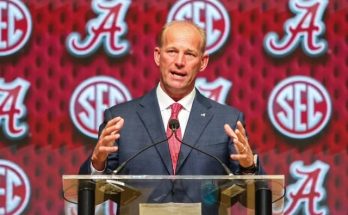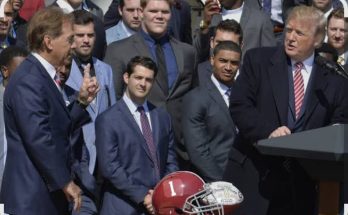When discussing powerhouse programs in college football, Ohio State consistently ranks among the elite. Year after year, the Buckeyes dominate opponents with a blend of talent, coaching prowess, and tradition. But beneath the surface of success lies a growing issue that, surprisingly, many fans and analysts are either overlooking or downplaying. This problem, while not as obvious as a losing streak or a major injury, could have significant ramifications for the future of the program if left unaddressed. The question is, why is Ohio State’s biggest problem flying under the radar, and what exactly is this issue?
To fully understand the gravity of this situation, it helps to step back and look at the Buckeyes’ recent trajectory. Ohio State has long been a juggernaut, consistently competing for Big Ten titles and making regular appearances in the College Football Playoff. The recruiting pipelines remain strong, the coaching staff is experienced and highly regarded, and the facilities are top-notch. On paper, everything looks perfect. So why do some insiders whisper about cracks in the foundation?
The biggest problem the Buckeyes face right now is something far less tangible than wins and losses: a lack of identity and consistency on offense, combined with a growing disconnect between the coaching philosophy and the evolving college football landscape. It’s a subtle issue that doesn’t grab headlines but has the potential to derail the program’s success if it festers.
One major symptom of this problem is the revolving door at the quarterback position over recent seasons. Ohio State has struggled to establish a clear, long-term starter who can lead the team with confidence. While flashes of brilliance have come from several signal-callers, the constant shuffling breeds instability. The offensive schemes seem to fluctuate depending on the quarterback in use, leading to inconsistency in performance. Fans may chalk it up to the natural growing pains of a new player or unfortunate injuries, but the underlying issue is that Ohio State has not locked in a quarterback who fully fits and can execute the vision of the coaching staff.
This inconsistency spills over into the offensive line and skill positions as well. The Buckeyes often boast elite recruits, but translating that raw talent into cohesive, reliable production has been a challenge. The offensive line has struggled with pass protection and run blocking at times, putting additional pressure on quarterbacks and limiting the effectiveness of running backs and receivers. Despite top-tier talent, the unit’s cohesion and execution seem uneven. This not only affects game outcomes but also hinders player development and confidence.
Another contributing factor to Ohio State’s quiet crisis is a subtle clash between traditional offensive schemes and the evolving style of college football offenses nationwide. The sport is shifting toward faster, more dynamic, spread-based offenses that emphasize tempo, misdirection, and versatile playmakers. Meanwhile, Ohio State’s offense has at times felt stuck between an old-school power-running mentality and a modern spread attack. This “in-between” approach can make the Buckeyes predictable and less explosive compared to their peers. It also challenges the coaches to find the right balance between maintaining their identity and adapting to the new realities of the game.
This strategic uncertainty isn’t just about playcalling — it has ripple effects on recruiting and player retention. Top high school quarterbacks and skill players often want to join programs where the system maximizes their strengths and allows them to showcase their talents for future NFL prospects. If Ohio State struggles to define a clear offensive identity or adapt swiftly, recruits may look elsewhere to programs with more modern and dynamic offenses. While Ohio State’s brand and prestige still attract elite athletes, prolonged uncertainty could chip away at this advantage.
Off the field, another layer of complexity has emerged with transfer portal activity. The portal era has changed college football’s landscape dramatically, giving players more freedom to move if they feel they’re not being utilized or developed properly. Ohio State has seen notable players enter and exit the program, and while this is common across many schools, it’s worth examining if the transfer trends point to dissatisfaction within the team. Are players leaving because they don’t see a clear role? Are new transfers fitting into the system quickly? The answers could shed light on deeper issues related to coaching stability and player development.
Fans tend to focus heavily on the outcomes of games, which makes sense — wins and losses are the clearest markers of success or failure. However, because Ohio State still manages to put up impressive results overall, these underlying problems don’t get the attention they deserve. The program’s high standards mask gradual declines in certain areas, causing many supporters to miss warning signs until they manifest in a more visible way.
Furthermore, media narratives and hype often concentrate on Ohio State’s recruiting rankings and occasional big wins, reinforcing the perception that all is well. But this surface-level success can be deceptive, glossing over subtler challenges such as offensive identity, player retention, and development. The lack of glaring losses or scandals means that the problem remains largely invisible to casual observers and even some dedicated fans.
The coaching staff’s response to these issues is critical. While they’ve maintained success and kept Ohio State competitive, a failure to decisively address the offensive inconsistency and evolving football trends could hinder their ability to sustain dominance. This calls for adaptability, innovation, and perhaps even a shift in recruiting focus or scheme philosophy. Balancing tradition with progress is never easy, especially at a program as storied as Ohio State, but it is essential to stay ahead of the curve.
If these concerns continue to go unacknowledged, Ohio State risks sliding from national title contender to a good-but-not-great program. The margin for error in college football is razor-thin, and the landscape is filled with hungry teams eager to capitalize on any sign of weakness from perennial powers. The Big Ten itself is becoming increasingly competitive, with programs investing heavily to close the gap on Ohio State. This means that maintaining status quo is not enough — the Buckeyes must evolve.
For fans, the key is to stay informed beyond the scoreboard and headline moments. Understanding the nuances of team dynamics, coaching philosophy, and player development provides a more complete picture of the program’s health. While it’s natural to celebrate victories and talent, it’s equally important to recognize when there are areas that need improvement before they grow into crises.
In conclusion, Ohio State’s biggest problem flying under the radar is the subtle but impactful lack of offensive identity and consistency, coupled with the challenges of adapting to the modern college football environment. This issue is not yet headline news because the Buckeyes continue to win enough to maintain their reputation. However, the longer it remains unaddressed, the greater the risk to the program’s future success. Fans, analysts, and the coaching staff should pay closer attention to these underlying dynamics and push for solutions that ensure Ohio State stays at the pinnacle of college football for years to come.



